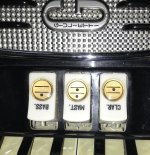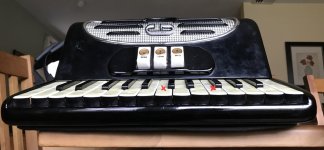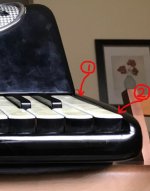It doesn't look like the end of the pin serves any purpose, so I'd just grind it down by 2mm or thereabout.Yes, I suppose I could try that. Maybe a little spot Dremel grinding on the register block (removed from the box, of course). I’ve been hesitant to make permanent changes, but I think that’s a small enough change that it wouldn’t be too bad.
For the picture where the arm is hitting the pin behind one of the register switches, do you think I can shorten the pin a tiny bit (cut a little bit off) without risking failure of the switch? I tried to file the pin a bit to shorten it and soften its edges, but without much success. I have a feeling it will poke through the duct tape in only a short time and the clicking will be back for that key.
But another approach to the problem entirely would be to check whether when the accordion is fully reassembled the register mechanism is actually sitting in the right position. Assuming the accordion must have worked correctly when it was new some "abuse" may have caused the whole mechanism to go down a bit (closer to the keyboard levers) and could be raised up by maybe 2mm to alleviate the problem without bending or removing anything on the keyboard itself, just on the supports of the register mechanism. I have often seen people place folders with music, or even a folded-up music stand, on the treble side, when putting the accordion in its carrying case. Repeated small bumping or pressure on the register mechanism can damage it over time and push it down.
Last edited:



